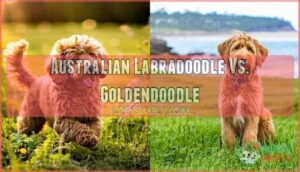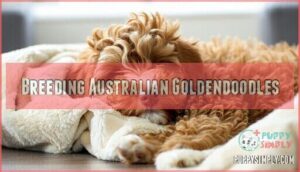This site is supported by our readers. We may earn a commission, at no cost to you, if you purchase through links.

An Australian Goldendoodle combines three breeds: Golden Retriever, Poodle, and Cocker Spaniel.
This triple mix creates a medium-sized pup weighing 25-45 pounds with a friendly personality that’s perfect for families.
Unlike regular Goldendoodles, they’re more predictable in size and temperament thanks to multi-generational breeding.
You’ll love their low-shedding coats and smart, trainable nature.
They come in various colors like red, white, and merle patterns.
Think of them as the Goldilocks of designer dogs – not too big, not too small, but just right for most households.
But there’s more to keep in mind before bringing one home.
Table Of Contents
- Key Takeaways
- What is an Australian Goldendoodle?
- How Big Do Australian Goldendoodles Get?
- Australian Goldendoodle Vs. Regular Goldendoodle
- Australian Labradoodle Vs. Goldendoodle
- Breeding Australian Goldendoodles
- Temperament and Family Life
- Lifespan and Health Issues
- Basic Care Needs
- Prices and Expenses
- Parent Breeds
- Frequently Asked Questions (FAQs)
- What is an Australian goldendoodle?
- Is an aussiedoodle the same as a goldendoodle?
- Are Australian mini goldendoodles good family dogs?
- How do I find a good Australian goldendoodle breeder?
- Are Australian goldendoodles good service dogs?
- What is the second parent breed of Australian goldendoodle?
- What is the difference between a Goldendoodle and an Australian Goldendoodle?
- How big do Australian Goldendoodles get?
- Do Australian Goldendoodles shed?
- What is the lifespan of an Australian Goldendoodle?
- Conclusion
Key Takeaways
- You’re getting a unique designer dog that combines four breeds (Golden Retriever, Poodle, Labrador Retriever, and Cocker Spaniel) rather than just two like regular Goldendoodles, creating more predictable temperament and size.
- You’ll have a medium-sized family companion weighing 25-45 pounds with low-shedding coats, high intelligence, and gentle nature that’s perfect for households with children.
- You’ll need to budget $2,000-$5,000 upfront plus ongoing costs like professional grooming every 6-8 weeks ($75-150), quality food ($50-80 monthly), and regular veterinary care throughout their 10-15 year lifespan.
- You’ll want to find reputable breeders who health test parent dogs for hip dysplasia, eye conditions, and heart issues since these dogs can inherit genetic health problems from their diverse breed background.
What is an Australian Goldendoodle?
An Australian Goldendoodle isn’t just a Goldendoodle from Australia – it’s actually a designer dog created by crossing an English Goldendoodle with an Australian Labradoodle.
This unique doodle combines four amazing breeds into one incredible family companion that’s both beautiful and brilliant.
You’ll get a friendly, intelligent pup that combines traits from four different breeds: Golden Retriever, Poodle, Labrador Retriever, and Cocker Spaniel, making it a unique and intelligent companion.
Red Australian Goldendoodle
Choosing a Red Australian Goldendoodle means getting a stunning rust-colored companion with incredible red coat genetics.
These gorgeous doodle colors range from deep mahogany to bright copper, though color fading often occurs as puppies mature.
Red puppy prices typically run higher due to popularity, so finding red breeders requires patience and research.
Maintaining red color involves proper nutrition and sun protection.
These Goldendoodles combine the best traits of multiple parent breeds, creating intelligent, hypoallergenic family dogs.
This doodle breed offers the perfect balance of beauty and brains for your household.
White Australian Goldendoodle
White Australian Goldendoodles often steal hearts with their angelic appearance and gentle temperament. This doodle breed showcases stunning coat genetics that produce pure white or cream-colored fur, sometimes with subtle markings around the ears or paws.
Unlike darker doodle colors, white shedding becomes more noticeable on clothing and furniture, though these hypoallergenic dogs still shed minimally. Breeding challenges arise when creating white Australian Goldendoodles, as pigment variations require careful selection of parent dogs.
Rare markings like small patches of cream or champagne add character to their snowy coats. You’ll find their coats range from straight to curly, all requiring regular brushing to prevent matting. These dogs are known for their low shedding qualities.
These gentle giants typically weigh 50-90 pounds and live 10-15 years. Their striking white appearance combined with the breed’s intelligent, family-friendly nature makes them highly sought after by families seeking a beautiful, loyal companion.
Merle Australian Goldendoodle
Standing out like a masterpiece in a gallery, Merle Australian Goldendoodles showcase stunning coat genetics that create marbled patterns of blue, gray, and cream.
You’ll find these pups display unique coat variations thanks to the merle gene’s unpredictable magic.
This Australian Goldendoodle variety combines intelligence from their multi-breed heritage with eye-catching looks.
However, merle genetics come with important considerations.
Double merle breeding can cause serious merle health issues, including hearing and vision problems.
When finding breeders, you’ll want someone who understands dog genetics thoroughly.
Responsible dog breeding means testing parents and avoiding double merle pairings.
The merle popularity has grown substantially, but don’t let pretty patterns blind you to health priorities.
These dogs need regular grooming to prevent matting.
Their coats require brushing every few days.
With proper breeding practices, you’ll get a healthy companion whose unique coat turns heads wherever you go.
How Big Do Australian Goldendoodles Get?
Australian Goldendoodle size variations range from tiny lap dogs to gentle giants, depending on their parent breeds.
Your pup’s final weight hinges on growth factors like genetics, diet, and the Poodle parent’s size.
Most reach full maturity by 18 months.
Here’s what to expect for goldendoodle size ranges:
- Mini goldendoodle: 10-40 pounds, 14-20 inches tall
- Medium: 30-45 pounds, 17-20 inches tall
- Standard goldendoodle: 50-90 pounds, 21-24 inches tall
- Measuring height: From ground to shoulder when standing
Weight ranges depend heavily on the maturity timeline and breeding choices.
Both breeds benefit from hybrid vigor advantages.
Australian Goldendoodle Vs. Regular Goldendoodle
Two popular poodle mix breeds often get confused, but Australian Goldendoodles and regular Goldendoodles have key differences.
While both are intelligent family dogs, the Australian version tends to be slightly smarter, and the regular Goldendoodle is considered more friendly.
Both work great with kids and need professional grooming every 8-12 weeks.
| Feature | Australian Goldendoodle | Regular Goldendoodle |
|---|---|---|
| Weight Range | 50-65+ lbs | 50-75+ lbs |
| Temperament | Slightly smarter | More friendly |
| Genetic Differences | Multi-generational breeding | Golden Retriever + Poodle |
These breed standards create temperament variations, though appearance comparison shows both maintain similar coat types and health concerns.
Australian Labradoodle Vs. Goldendoodle
Choosing between these doodle mixes comes down to understanding their key differences.
Australian Labradoodles blend Labrador Retriever, Poodle, and Cocker Spaniel genes, while Goldendoodles combine Golden Retriever and Poodle traits.
This breed composition creates distinct characteristics that’ll help you pick your perfect companion.
| Feature | Australian Labradoodle | Goldendoodle |
|---|---|---|
| Weight Range | 20-65 lbs | 15-90 lbs |
| Temperament | Calmer, more consistent | Playful, energetic |
| Coat Type | Curly/wavy, low-shedding | Curly, wavy, or straight |
| Lifespan | 12-15 years | 10-15 years |
Australian Labradoodles typically offer more predictable temperament variance and coat differences due to their multi-generational breeding.
Both breeds were created for specific breeding purposes, like companionship.
Breeding Australian Goldendoodles
Creating these adorable pups requires careful planning and expertise. Australian Goldendoodle breeding combines F1 English Goldendoodles with multi-generational Australian Labradoodles.
Reputable breeders focus on genetic diversity through health testing for hip dysplasia and eye conditions. Breeding generations affect coat inheritance – some get wavy coats, others curly.
Ethical considerations include screening parent dogs and proper socialization. Dog breeding isn’t just mixing breeds; it’s about creating healthy, well-tempered companions.
A goldendoodle breeder should provide health certificates and demonstrate commitment to responsible breeding practices.
Temperament and Family Life
Your Australian goldendoodle’s temperament makes them perfect family pets.
These dogs blend intelligence with gentle nature, creating ideal companions for households with children.
Their goldendoodle temperament shines through daily interactions.
Here’s what makes them family-friendly:
- Child Compatibility – They’re patient and gentle with kids of all ages
- Training Ease – Their intelligence makes learning commands simple
- Affectionate Nature – They thrive on human connection and cuddles
Energy Levels stay moderate, while Socialization Needs require regular interaction with people and pets for best development.
Lifespan and Health Issues
Your Australian Goldendoodle’s journey spans 10-15 years with proper care.
With love and proper care, your Australian Goldendoodle will be your faithful companion for over a decade of adventures.
These doodle health issues stem from their diverse genetic background, making genetic screening essential before bringing your pup home.
| Health Category | Common Conditions | Prevention Strategy |
|---|---|---|
| Joint Problems | Hip/elbow dysplasia | Regular vet checkups, weight management |
| Eye Issues | Progressive retinal atrophy, cataracts | Annual eye exams, genetic testing |
| Heart Conditions | Aortic stenosis | Cardiac screenings, moderate exercise |
| Digestive Problems | Bloat, food allergies | Proper diet impact, smaller meals |
| Skin Allergies | Environmental reactions | Preventative care, quality nutrition |
Preventative care beats reactive treatment every time.
Your exercise needs and diet choices directly influence these genetic health conditions throughout your dog’s life.
Basic Care Needs
Your Australian Goldendoodle needs daily exercise, proper nutrition, and regular grooming to stay healthy and happy.
You’ll want to focus on three main areas: feeding them quality food, providing enough physical activity, and keeping their coat well-maintained, which includes nutrition.
Food and Diet
Feeding your Australian Goldendoodle right sets the foundation for a happy, healthy life. Quality dog food should match your pup’s life stage.
Puppy nutrition requires higher calories and protein for growth. Adult diet needs balanced nutrients to maintain energy. Senior diet should support aging joints and organs.
Choose premium kibble with real meat as the first ingredient. Watch for food allergies like chicken or grain sensitivities.
Weight management matters since these dogs love their meals. Feed measured portions twice daily rather than free-feeding.
Fresh water should always be available. Avoid table scraps that can upset their stomach. Good dog nutrition prevents many health issues down the road.
Training and Exercise
Good training and regular exercise keep your Australian Goldendoodle happy and well-behaved.
These dogs are smart and keen to please, so positive reinforcement works wonders.
Use treats, praise, or a favorite toy to reward good behavior during goldendoodle training sessions.
Keep it fun but consistent.
Meeting their exercise needs is just as important.
These energetic pups love activities that challenge their minds and bodies.
Try agility training or games like fetch to burn off energy while boosting mental stimulation.
For mental enrichment, consider interactive treat dispensers.
Here’s a quick guide to keep them thriving:
- Daily Walks: Aim for at least 45 minutes.
- Puppy Socialization: Introduce them to new people, pets, and places early.
- Interactive Play: Puzzle toys or hide-and-seek keep them sharp.
A tired Goldendoodle is a happy Goldendoodle!
Cleaning and Grooming
Your fluffy companion’s grooming requirements aren’t as intimidating as they might seem. Coat brushing needs to happen at least twice weekly to prevent matting and tangling. Use a slicker brush for their wavy or curly coat.
Bath frequency should be every six to eight weeks with gentle, hypoallergenic shampoo to maintain coat health. Professional grooming every six to eight weeks keeps your doodle looking sharp.
Between visits, focus on ear cleaning weekly to prevent infections, and nail trimming monthly. Don’t forget daily teeth brushing for overall health. A proper routine requires a quality grooming brush.
Here’s your essential doodle grooming checklist:
- Daily brushing for high-maintenance coats
- Weekly ear cleaning with veterinarian-approved solution
- Monthly nail trims to prevent overgrowth
These dog grooming tips will keep your Australian Goldendoodle healthy and happy.
Prices and Expenses
Bringing home an Australian goldendoodle means preparing your wallet for several expenses.
The initial cost ranges from $2,000 to $5,000, depending on your breeder’s reputation and the puppy’s lineage.
Adoption from rescue organizations offers a budget-friendly alternative at around $500.
Beyond the goldendoodle price, you’ll face ongoing expenses.
Grooming expenses run $75-150 every 6-8 weeks.
Food costs average $50-80 monthly for quality kibble.
Healthcare costs include vaccinations, check-ups, and potential emergencies.
Training fees can add $100-300 for basic obedience classes.
Understanding the Australian goldendoodle cost is essential for responsible ownership.
Parent Breeds
Your Australian Goldendoodle inherits traits from three key parent breeds that shape their personality and appearance.
You’ll find DNA from Poodles, Cocker Spaniels, and Labrador Retrievers working together to create this friendly and intelligent companion.
Poodle
Poodles bring intelligence and athleticism to the Australian Goldendoodle mix.
This dog breed originated in Germany as water retrievers, developing their signature curly coat for protection.
Poodle genetics contribute the low-shedding trait that makes this Poodle mix appealing to families.
Their Poodle coat requires regular brushing to prevent matting.
Poodle history shows three sizes: standard, miniature, and toy.
Poodle health issues include hip dysplasia and eye problems.
Poodle grooming needs are high-maintenance.
The Doodle’s trainability comes directly from Poodle intelligence and willingness to please.
Mini poodles, known for their intelligence, need consistent mental stimulation.
Cocker Spaniel
While Poodles bring intelligence to the Australian Goldendoodle mix, Cocker Spaniels add their own special charm to this designer dog breed.
The Cocker Spaniel’s breed history dates back to hunting dogs in Spain, and they’ve been winning hearts ever since.
You’ll find two main types in this poodle mix: American Cockers with their distinctive eyes and English Cockers sporting longer ears.
The Cocker temperament shines through with enthusiastic-to-please attitudes and gentle spirits – perfect traits for family life.
Spaniel grooming needs are significant.
Their silky coats require regular brushing to prevent matting, something your Australian Goldendoodle will inherit.
Cocker health considerations include ear infections due to those adorable floppy ears, plus potential eye issues.
Spaniel training responds well to positive reinforcement since they’re natural people-pleasers.
This makes your Australian Goldendoodle easier to train, combining the Cocker’s willingness with Poodle smarts.
Labrador Retriever
Labrador Retrievers bring boundless energy and unwavering loyalty to the Australian Goldendoodle mix.
These water-loving athletes originally helped fishermen in Newfoundland, which explains why your poodle mix might leap into every puddle they see.
Labrador Temperament shines through gentle patience with children and endless enthusiasm for family activities.
You’ll find they’re natural people-pleasers who thrive on human connection.
Labrador Training becomes surprisingly easy since they’re keen to learn and respond well to positive reinforcement.
Labrador Exercise needs run high – expect at least 60 minutes of daily activity.
Without proper outlets, they’ll turn your couch into a chew toy.
Labrador Grooming stays minimal with their double coat, though your Australian Goldendoodle inherited more complex grooming needs from other parent breeds.
Labrador Health concerns include hip dysplasia and eye problems, which responsible breeders screen for when creating Australian Labradoodle crosses.
This sturdy foundation helps create the balanced, family-friendly Goldendoodle temperament you’ll love.
Frequently Asked Questions (FAQs)
What is an Australian goldendoodle?
You’re looking at a designer dog that’s half Australian Labradoodle, half English Goldendoodle. They’re friendly, intelligent family pets with low-shedding coats, weighing 15-80 pounds depending on size variety.
Is an aussiedoodle the same as a goldendoodle?
Despite common confusion, Aussiedoodles aren’t the same as Goldendoodles. You’re looking at two different mixes: Aussiedoodles combine Australian Shepherds with Poodles, while Goldendoodles blend Golden Retrievers and Poodles together.
Are Australian mini goldendoodles good family dogs?
Yes, you’ll find mini Australian Goldendoodles make excellent family pets.
They’re gentle with kids, intelligent, and easy to train.
Their friendly nature and moderate energy level fit perfectly into busy family life.
How do I find a good Australian goldendoodle breeder?
Research breeders who health test parent dogs for hip dysplasia, eye conditions, and heart issues.
Visit facilities, meet parent dogs, ask for references, and verify breeding practices prioritize temperament and health over profit.
Are Australian goldendoodles good service dogs?
Service dogs complete over 180 different tasks for their handlers.
Australian Goldendoodles excel as service dogs because they’re highly intelligent, trainable, and gentle.
Their low-shedding coats and calm temperament make them perfect companions for people with disabilities.
What is the second parent breed of Australian goldendoodle?
The second parent breed you’re looking at is the English Goldendoodle. Australian Goldendoodles come from crossing Multi-Generational Australian Labradoodles with Multi-generational English Goldendoodles, creating this unique designer dog combination.
What is the difference between a Goldendoodle and an Australian Goldendoodle?
You’ll find a Goldendoodle mixes Golden Retriever and Poodle genes, while an Australian Goldendoodle combines four breeds: Golden Retriever, Labrador Retriever, Poodle, and Cocker Spaniel for more diverse traits.
How big do Australian Goldendoodles get?
Coincidentally, you’re wondering about size just as your puppy’s growing.
Australian Goldendoodles typically reach 17-24 inches tall and weigh 15-80 pounds.
Mini versions stay smaller at 20-30 pounds, while standard ones can hit 90 pounds, and it’s interesting to note the size variation in Australian Goldendoodles.
Do Australian Goldendoodles shed?
You’ll find these pups shed minimally thanks to their Poodle genes.
While they’re not completely shed-free, their low-shedding coats make them suitable for many allergy sufferers who struggle with traditional breeds.
What is the lifespan of an Australian Goldendoodle?
You’ll enjoy years of companionship, walks, and cuddles with your furry friend. Australian Goldendoodles typically live 10-15 years, with smaller varieties often reaching the higher end of this range.
Conclusion
Ready to welcome your perfect furry companion? The Australian goldendoodle offers everything most families want in a dog.
You’ll get a medium-sized pup with predictable traits, minimal shedding, and an amazing temperament. These smart dogs adapt well to different lifestyles and bond closely with their families.
Remember to budget for quality food, regular grooming, and veterinary care. With proper care and training, your Australian goldendoodle will become a loyal family member for years to come.
















